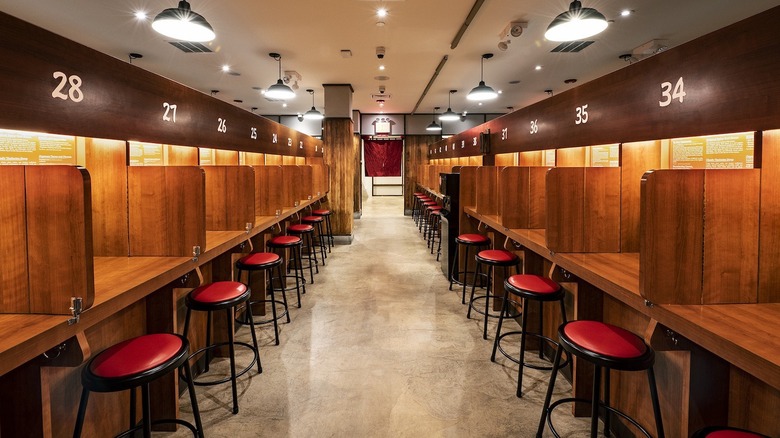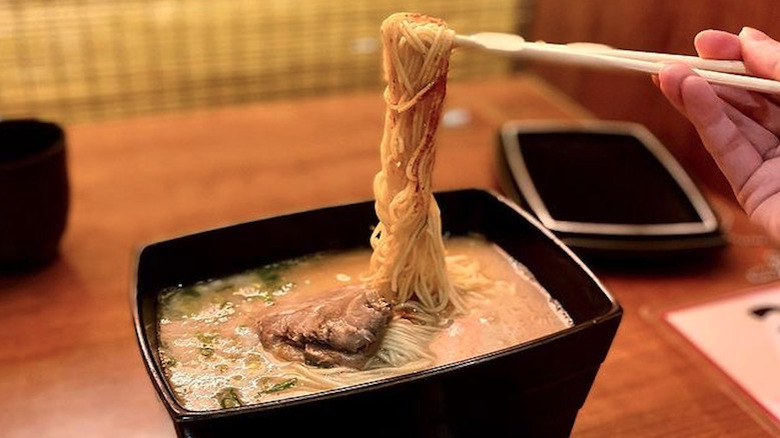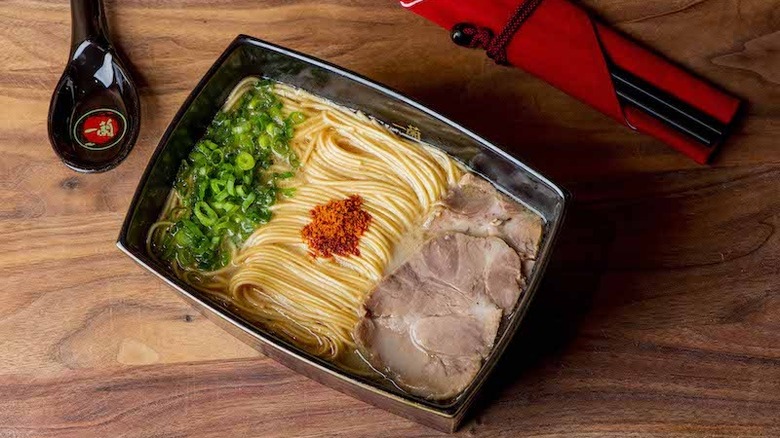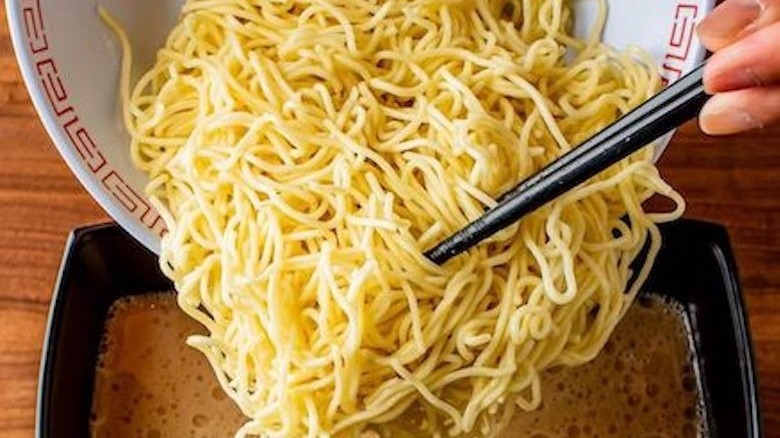Ichiran: The Japanese Ramen Restaurant That Is Every Introvert's Dream
For some people, eating alone in a restaurant is a nightmare. For others, it's nirvana. Ichiran, a string of Japanese ramen cafés with 85 locations, including three in New York City — Brooklyn, Midtown, and Times Square — presents a happy middle ground. Guests dine in individual booths that look more like office cubicles than restaurant seating, and everyone eats alone. That means patrons ranging from social introverts who just need a bit of "me" time to recharge between meetings to solomangarephobics who have a bonafide fear of dining alone are likely to feel right at home.
But the unique dining configuration wasn't created with privacy in mind. Instead, Ichiran's seating design is the brainchild of Manabu Yoshitomi, the founder of the chain that began as a small family enterprise in 1960. And it predates Yoshitomi's Ichiran — it all began when Yoshitomi was a student apprenticing at a local restaurant to help with family finances. The chef/owner had so much faith in his young protégé that he occasionally left him on his own to run the restaurant. Everything was going smoothly until the day a regular customer challenged Yoshitomi, asserting that his ramen was fine, just not as good as the owner's — even though he was following the exact same recipe. The next time the customer came in, Yoshitomi was ready. He didn't mention the owner was not on site, and he prepared the customer's order out of plain view.
Where it all began
Wonder of wonders, the customer declared the master's skills incomparable, never realizing he was eating ramen made by the young apprentice. The seed of an idea began to take root. In 1993, when Manabu Yoshitomi was getting ready to open his first ramen restaurant, he did a bit of impromptu market research, talking to potential customers in the area. One key bit of information he discovered was that local women didn't like slurping ramen in public restaurants. "These comments and his experience as a young chef gave him the idea to create the solo ramen focus booths," Annie Chen, a spokesperson for Ichiran, told Tasting Table. "His own experience taught him that keeping the chefs away from the customer's eyes helps create a sense of mystery that enhances the flavors of the food."
Yoshitomi's ramen, and the concept of dining solo in purpose-designed booths, took off. And so did Yoshitomi's imagination. In an effort to further limit distractions, he began to brainstorm ways to streamline the ordering process, ultimately installing tabletop sensors to alert staff when a customer was ordering. "This was before the technology advanced to its current level of order through pads and AI, so the use of these sensors was a unique experience for the customers," Chen said. Yoshitomi's flagship restaurant, originally named Nanokawa, is still open in Fukuoka, Japan. Along the way, he built his brand, acquiring a small chain of ramen cafés named Ichiran and adding new outlets at locations in Japan, Taiwan, Hong Kong, and the U.S.
Getting it just right
Ichiran, which specializes in tonkotsu ramen, a Fukuoka specialty made with pork bone broth and long, thin noodles, debuted its first U.S. location in 2016. Back then, TimeOut New York covered the opening of the Brooklyn restaurant, reporting on the streamlined ordering process that begins when a customer submits a completed order form. Although the process is relatively simple, the choices — encompassing everything from broth strength to noodle texture — may seem overwhelming to ramen novices. Fear not — Ichiran's Annie Chen has a few suggestions.
"For guests visiting us for the first time, our order forms come with a dotted circle around the options we suggest will provide you with a tasty bowl that is neither too light in flavor, nor too strong," Chen told Tasting Table. "Like Goldilocks' favorite porridge, it is 'just right' to create a baseline to help you decide what your preferences are for your next visit." For first-timers, Chen suggests sticking to the middle ground, as in medium dashi flavoring, medium richness (a measure of oil content), medium or level one "spicy sauce," and medium-textured noodles. For add-ons, Chen suggests choosing scallions and chashu (pork slices). Other add-on topping options on the Ichiran order form include kikurage mushrooms, soft-boiled egg, dried seaweed, white rice, and Osukaran vinegar.
Tips to know before you go
Assuming your order turns out "just right," you may want to consider saving some of your toppings for kae-dama. The Japanese equivalent of a second helping of noodles, kae-dama, which translates to "new ball," comes in half- and full-size servings. According to Chen, kae-dama is a good way for newbies to sample different noodle textures in one sitting. As for timing, Chen advises placing your kae-dama order when you're about half-way through your first serving. Oh, go ahead. You're dining alone. Who's going to know?
One final tip: While Ichiran is built on the concept of solo dining, it's perfectly okay to bring a friend and sit in side-by-side booths. You'll have to converse in muted tones, though — Ichiran isn't exactly a silent-like-a-library experience, but discretion is advised. "We may ask a guest to lower their voice if they get too excited or too loud," Chen said. "This doesn't happen often as our guests are seated close enough to have a private conversation without the need to shout."



